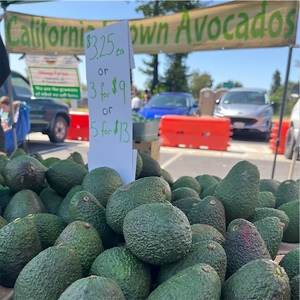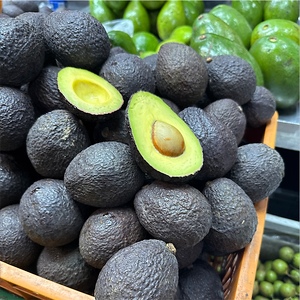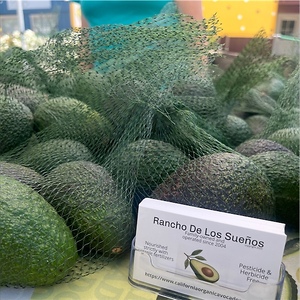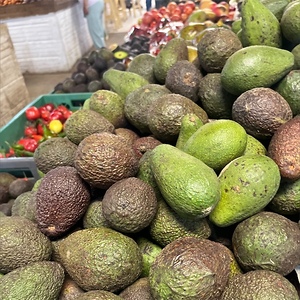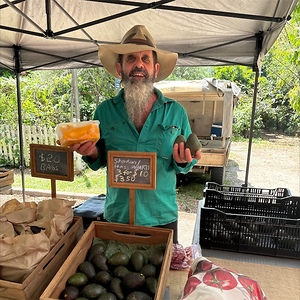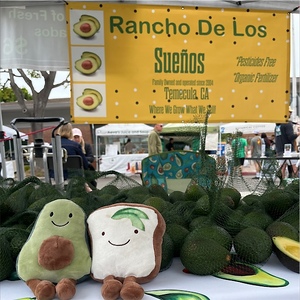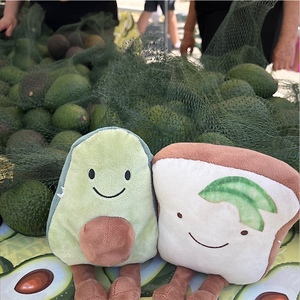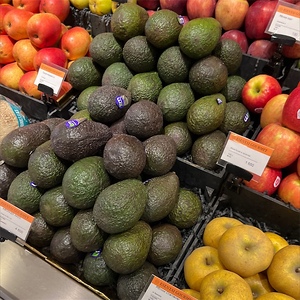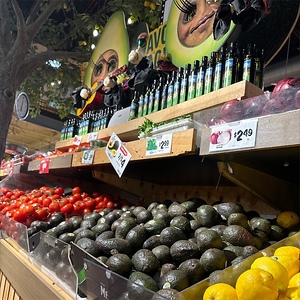

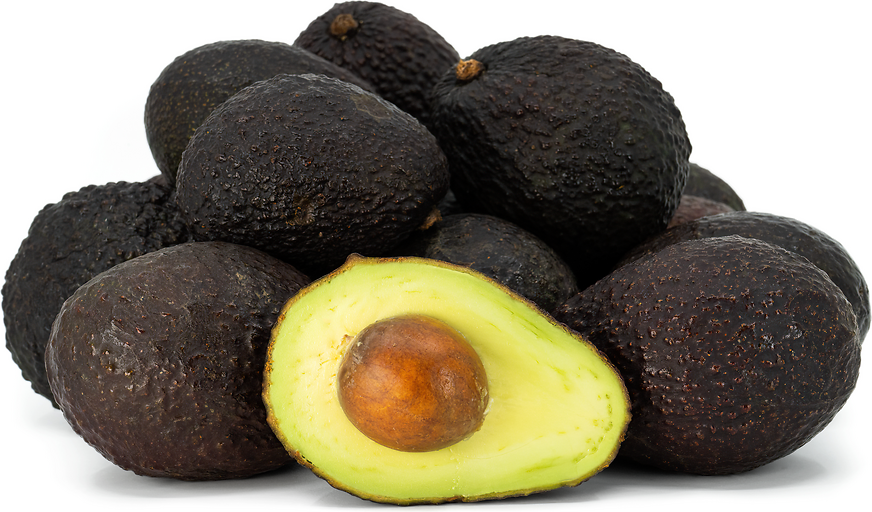
Hass Avocados
Estimated Inventory, 60 ct : 341.97
This item was last sold on : 06/30/25
Description/Taste
Hass avocados vary in size, depending on growing conditions, but are generally medium-sized, averaging 7 to 15 centimeters in diameter and 141 to 300 grams in weight. The variety has an oval, oblong, to pyriform shape with blunt, slightly tapered curved ends and features a rough, woody button on the stem end. The skin ripens from green to dark green, sometimes darkening to shades of green-purple, almost black. The skin is also glossy and is textured, pebbled, thick, and taut. Hass avocados are easy to peel, revealing dense, yellow-green flesh. The flesh is firm when young, softening to a tender, creamy, and fibreless consistency when ripe. The flesh also envelops a moderately sized, round brown seed tightly embedded into the flesh. Hass avocados are known for their high oil content, creating a rich, nutty, savory, earthy, and subtly sweet taste.
Seasons/Availability
Hass avocados are grown in both hemispheres, creating year-round availability.
Current Facts
Hass avocados, botanically classified as Persea americana, are a California variety belonging to the Lauraceae family. The bumpy-skinned fruits grow on upright trees reaching 4 to 9 meters in height and are one of the most commercially produced avocado varieties worldwide. Hass avocados were discovered in the early 20th century and later became famous for their distinct coloring, growth characteristics, and hardy nature. Before the rise of Hass avocados, Fuerte avocados were the dominant variety grown in California. Hass avocados initially stood out for their thick, dark-colored skin, but with time, growers appreciated the variety’s high yields, ease of propagation, and ability to be transported long distances without damage. It is important to note that the pronunciation of Hass avocados is based on a family’s last name. It should be pronounced similarly to “pass” but with an “h.” Since their discovery, Hass avocados have expanded in cultivation worldwide and are the primary avocado sold in fresh markets as a culinary ingredient.
Nutritional Value
Hass avocados are a source of fiber to stimulate and cleanse the digestive tract, magnesium to control nerve functions, and potassium to balance fluid levels within the body while replenishing electrolytes. Hass avocados also provide vitamins A, B, C, E, and K. These vitamins help the body strengthen the immune system, guard the cells against free radical damage, maintain healthy organs, produce energy, and aid in faster wound healing. In addition to consuming avocados, the fruits are topically incorporated into facial masks and hair treatments as a calming, moisturizing ingredient.
Applications
Hass avocados are known for their rich, nutty, and creamy nature, suited for fresh and cooked preparations. The variety can be used in any preparation, calling for avocado, and has a higher oil content than other more watery cultivars. Hass avocados can be halved and eaten out of hand with a spoon, or their halves can be filled with nuts, salads, or meat as a simple snack. The variety can also be sliced and served over tacos, on sandwiches, rolls, and in wraps, mashed and slathered on toast, or used as an edible topping over salads, grain bowls, and main dishes. Hass avocados are versatile and can be cubed, sliced, mashed, or cut, holding their shape. They are also blended into sauces and dressings or added to smoothies for a thicker consistency. One of the most famous uses for Hass avocados is making guacamole. When slicing fresh or using in dips, sprinkling lemon juice onto the flesh is recommended to slow browning. Worldwide, Hass avocados have adapted to many cuisines and are utilized according to preference. The variety is also occasionally stuffed and baked or cut into strips, breaded, and fried as an appetizer. Hass avocados pair well with herbs such as cilantro, parsley, chives, and basil, spices including cumin, curry powder, turmeric, and paprika, citrus, honey, tomatoes, bell peppers, onions, and garlic. Avocados should be ripened at room temperature, away from direct sunlight. Mature fruits should be immediately consumed for the best quality and flavor and will last 2 to 3 days in the fridge. Once opened, cover the exposed flesh with lemon juice and tightly wrap it before placing it in the refrigerator. This will keep the sliced half fresh for a day or two.
Ethnic/Cultural Info
Hass avocado trees commercially grown in the present day are descendants of the original tree in the Hass family orchard, also known as the “Mother Tree.” Hass avocado trees are developed through propagated cuttings rather than growing from seed, and these cuttings initially began from the Mother Tree in La Habra Heights. The Hass Mother Tree lived for 76 years in the same location until it succumbed to root rot in 2002. After the tree’s passing, the Brokaw family had a cross-section of the Mother Tree varnished and preserved in memory of the variety. A branch was also taken and sealed in glass with a note saying, “Though her fruit has spread around the world, her roots will always be in California.” Beyond preserving portions of the Mother Tree, the California Avocado Society installed a commemorative plaque at the site of the Mother Tree in La Habra Heights to remember the story of the now global fruit.
Geography/History
Hass avocados arose from a chance seedling in California in the early 20th century. The story of Hass avocados is connected to the story of the Hass family. Mr. Rudolph Hass was a postman who purchased a 1.93-acre plot of land in La Habra Heights in Los Angeles. Mr. Hass desired to plant avocado trees as a potential source of income, and in the 1920s, he bought a bag of avocado seeds from a local grower based in Whittier named A.R. Rideout. The seeds were grown into seedlings, and in 1926, they were planted on the property. After becoming established, Mr. Hass began attempting to graft branches onto the seedlings to grow varieties distinct from the commercially dominant Fuerte avocado. One of the seedlings rejected the grafts for several years, and at one point, it was said that Mr. Hass was ready to cut the tree down. Mr. Hass kept the tree alive, and in 1931, the unusual seedling produced its first six fruits, which were much darker in color and had distinct pebbled features. The following year, the tree produced 125 fruits, and Mr. Hass’s children became fond of the fruit’s rich flavor. It is unknown what the variety’s true genetic heritage is, but some studies conducted later in the 21st century indicate the cultivar has Guatemalan and Mexican origins. In 1935, Mr. Hass patented the new variety after his family’s name and brokered a deal with Whittier grower Harold H. Brokaw to grow additional trees and promote the cultivar. Hass avocados were initially met with some resistance, as they were visually distinct from other popular commercial avocados at the time, but they were later valued for their different ripening time and hardiness. In the 1950s, producers in Mexico and California began commercially cultivating Hass avocados, and by the 1970s and 80s, Hass avocados became the choice cultivar. Today, Hass avocados are the most commercially produced avocado variety worldwide and are widely found in fresh markets, through grocers, and distributors. They are also grown in home gardens in both hemispheres.
Featured Restaurants
Restaurants currently purchasing this product as an ingredient for their menu.
| Relic Bageri LLC | San Diego CA | 619-335-6328 |
| Trust Restaurant | San Diego CA | 609-780-7572 |
| Lucky Bolt | San Diego CA | 662-832-3638 |
| Top of the Market | San Diego CA | 619-234-4867 |
| Polaris Supreme | San Diego CA | 619-390-7890 |
| Mitch's Seafood | San Diego CA | 619-316-7314 |
| Happy Medium SD | San Diego CA | 509-869-2279 |
| Morning Glory | San Diego CA | 619-629-0302 |
| Belmont Park Draft | San Diego CA | 858-228-9283 |
| Knotty Barrel- Rancho | San Diego CA | 858-484-8758 |
| Tribute Pizza | San Diego CA | 858-220-0030 |
| Cloak and Petal | San Diego CA | 626-319-6878 |
| Whiskey Girl | San Diego CA | 619-236-1616 |
| Terra Restaurant | San Diego CA | 619-293-7088 |
| Nobu | San Diego CA | 619-814-4124 |
| Shoreside Support Boat | San Diego CA | 704-277-7929 |
| Sushi Kami | San Diego CA | 858-451-7799 |
| Pamplemousse Grill | Solana Beach CA | 858-792-9090 |
| Sovereign Thai Cuisine | San Diego CA | 619-887-2000 |
| Lumi | San Diego CA | 619-955-5750 |
| Candor | La Jolla CA | 858-581-2205 |
| Espadin | Temecula California | 951-383-5585 |
| HiroNori Ramen | San Diego CA | 619-446-9876 |
| Rancho Bernardo Inn | San Diego CA | 877-517-9340 |
| Common Stock | San Diego CA | 619-310-5298 |
| Fox Point Farms (Haven) | Encinitas CA | 619-892-0553 |
| Madison | San Diego CA | 619-822-3465 |
| Campfire | Carlsbad CA | 760-637-5121 |
| Siamo Napoli | San Diego CA | 619-300-4810 |
| El Sueno | San Diego CA | 619-972-6286 |
| Rabbit Hole | San Diego CA | 619-255-4653 |
| Lofty Coffee Co-Encinitas | Encinitas CA | 760-230-6747 |
| Bar Ella | San Diego CA | 858-808-2286 |
| Scion Health | Escondido California | 442-277-6167 |
| Lofty Cafe-Roasting Works | Encinitas CA | 760-230-6747 ex. 5 |
| Sheraton Carlsbad (Banquets) | Carlsbad CA | 760-827-2400 |
| Shore Rider | La Jolla CA | 858-412-5308 |
| Harry's Coffee Shop | San Diego CA | 858-454-7381 |
| Mavericks Beach Club | San Diego CA | 858-999-0348 |
| Nectarine Grove | Encinitas CA | 760-944-4525 |
| Monarch School (Nutrition Lab) | San Diego CA | 619-804-1766 |
| Sbicca Del Mar (Bar) | Del Mar CA | 619-417-2587 |
| Vitality Tap - 1St Ave | San Diego CA | 619-237-7625 |
| Cellar Hand | San Diego CA | 334-689-2388 |
| DoubleTree By Hilton San Diego | San Diego CA | 619-881-6900 |
| Shorehouse Kitchen | La Jolla CA | 858-459-3300 |
| Waverly | Cardiff CA | 619-244-0416 |
| Le Parfait Paris - UTC | San Diego CA | 619-245-4457 |
| Miguel's Cocina Carlsbad | Carlsbad CA | 760-759-1843 |
| Harvest Kitchen | Vista CA | 619-709-0938 |
| The Whaling Bar (Bar) | La Jolla CA | 858-355-9218 |
| Fairmont Grand Del Mar | San Diego CA | 858-314-1975 |
| Marriott Courtyard Old Town | San Diego CA | 619-260-8500 |
| Giuseppe Restaurants & Fine Catering | San Diego CA | 619-436-7006 |
| Sisters Pizza | San Diego CA | 858-228-6822 |
| Lodge at Torrey Pines Grill | San Diego CA | 858-453-4420 |
| The Flower Pot Cafe and Bakery | La Jolla CA | 858-454-5453 |
| Saint Mark Golf and Resort, LLC | San Marcos CA | 508-320-6644 |
| Kairoa Brewing Company | San Diego CA | 858-735-0051 |
| Chocolate Bar | Carlsbad CA | 442-500-2007 |
| Jeune Et Jolie | Carlsbad CA | 858-231-0862 |
| South O Brewing Catering | Oceanside CA | 925-381-5392 |
| The Santaluz Club Inc - Banquet | San Diego CA | 858-759-3150 |
| Gravity Heights Restaurant and Brewery | San Diego CA | 858-551-5105 |
| The Corner Drafthouse | San Diego CA | 619-255-2631 |
| Fish 101 | Encinitas CA | 760-943-6221 |
| Del Mar Country Club | Rancho Santa Fe CA | 858-759-5995 |
| Sandpiper Wood Fired Grill & Oysters | La Jolla CA | 858-228-5655 |
| Park Commons - ARE | San Diego CA | 619-295-3172 |
| Sbicca Del Mar | Del Mar CA | 619-417-2587 |
| Something Homemade | Vista CA | 858-245-1004 |
| Rancho Valencia | Del Mar CA | 858-756-1123 |
| Pacifica Del Mar | Del Mar CA | 858-792-0505 |
| BFD-Big Front Door | San Diego CA | 619-723-8183 |
| Harmony Cuisine 2B1 | San Diego CA | 858-737-4777 |
| Marriott Gaslamp | San Diego CA | 619-696-0234 x6051 |
| Cal A Vie | Vista CA | 760-945-2055 |
| Le Coq | La Jolla CA | 858-427-1500 |
| Farmer and The Seahorse | San Diego CA | 619-302-3682 |
| Leucadia Pizza Scripps Ranch | San Diego CA | 858-530-2222 |
| Belmont Park Cannonball | San Diego CA | 858-228-9283 |
| Finca North Park | San Diego CA | 619-581-3003 |
| Kingfisher | San Diego CA | 619-861-8074 |
| Lafayette Hotel - Quixote | San Diego CA | 619-296-2101 |
| Leu Leu | Leucadia CA | 619-316-5807 |
| The Monsaraz | San Diego CA | 858-760-6228 |
| Brigantine Coronado | Coronado CA | 619-435-4166 |
| Himitsu | La Jolla CA | 858-345-0220 |
| The Flavor Chef (Catering) | Vista CA | 619-295-3172 |
| The Kitchen at MCASD | La Jolla CA | 619-880-8719 |
| Humphrey's | San Diego CA | 619-224-3577 |
| Blue Whale | La Jolla CA | 808-868-8639 |
| Tahona (Kitchen) | San Diego CA | 619-573-0289 |
| Hawaiian Fresh Seafood - Poway | Poway CA | 858-299-8862 |
| Green Acres Campus | San Diego CA | 858-450-9907 |
| La Valle Coastal Club | Rancho Santa Fe CA | 858-759-5473 |
| Sushi Nekosan | La Jolla CA | 858-999-0999 |
| Hilton Garden Inn | San Diego CA | 858-720-9500 |
| Sheraton Carlsbad (7 Mile) | Carlsbad CA | 760-827-2400 |
| Ju-Ichi | San Diego CA | 619-800-2203 |
| Le Parfait Paris - Downtown | San Diego CA | 619-245-4457 |
| Two Ducks (Deliver Lion Share) | San Diego CA | 619-564-6924 |
| The Local-Pacific Beach | San Diego CA | 858-263-7475 |
| Casa De Otay | Chula Vista CA | 619-600-7433 |
| Firefly Beach | San Diego CA | 619-222-6440 |
| Crest Cafe | San Diego CA | 619-295-2510 |
| Mission Ave Bar and Grill | Oceanside CA | 760-717-5899 |
| Rubicon Deli India Street | San Diego CA | 619-200-4201 |
| Third Corner Encinitas | Encinitas CA | 760-942-2104 |
| University Club | San Diego CA | 619-234-5200 |
| Brigantine Imperial Beach | Imperial Beach CA | 619-591-1350 |
| Pacific Terrace Hotel | San Diego CA | 858-581-3500 |
| Herb & Sea | Encinitas CA | 858-587-6601 |
| Harney Poway Sushi | Poway CA | 760-533-0051 |
| Haven | San Diego CA | 619-928-2086 |
| Brigantine Pt Loma | San Diego CA | 619-224-2871 |
| Crust Pizzeria Carlsbad 2019 | Carlsbad CA | 760-944-1111 |
| Pacific Cafe & Catering (Medical Cntr Dr.) | La Jolla CA | 619-808-4087 |
| The Harvest Honey | San Marcos CA | 616-914-0124 |
| SB Kitchen (Bar) | Solana Beach CA | 610-717-7217 |
| Fish Market Solana Beach | Solana Beach CA | 858-755-2277 |
| Miguel's Cocina Coronado | Coronado CA | 619-437-4237 |
| Palmys | San Diego CA | 858-886-7111 |
| The Barista Botanist | San Diego CA | 808-868-8639 |
| The Butchery | San Diego CA | 858-345-1524 |
| Hotel La Jolla - Sea & Sky | La Jolla CA | 858-459-0261 |
| Rustic Root Solana | Solana Beach CA | 619-955-5750 |
| Haggos Organic Tacos LLC | Encinitas CA | 760-695-8870 |
| Slowly | San Diego CA | 858-352-6080 |
| Hawaiian Fresh Seafood | San Diego CA | 858-299-8862 |
| The Sushi Stand | San Diego CA | 619-394-2395 |
| Green Dragon Tavern & Museum | Carlsbad CA | 760-797-5579 |
| Catania La Jolla | La Jolla CA | 619-884-5350 |
| Crown Point Catering | San Diego CA | 619-223-1211 |
| Sugar Bear Enterprises | San Diego CA | 925-383-3623 |
| Hilton La Jolla Torrey Pines | La Jolla CA | 858-450-4581 |
| Bang on 5th | San Diego CA | 619-677-5650 |
| Talitha Coffee | San Diego CA | 619-550-1830 |
| Nectarine Grove Bakehouse | Del Mar CA | 858-925-7357 |
| Sago | Encinitas CA | 858-382-4047 |
| Pendry SD (Lion Fish) | San Diego CA | 619-738-7000 |
| Jake's Del Mar | Del Mar CA | 858-755-2002 |
| Bishop School | San Diego CA | 858-459-4021 |
| Crafted @ Minerva's Cafe | La Jolla CA | 858-699-4129 |
| Elks Lodge 2698 -Donation | Lakeside CA | 619-390-4949 |
| Home & Away - Old Town | San Diego CA | 619-886-1358 |
| Extraordinary Desserts | San Diego CA | 619-294-2132 |
| Vista Valley | Vista CA | 760-758-2800 |
| Spirit of Adventure Sportfishing | San Diego CA | 619-454-9711 |
| Sets Kitchen and Bar | San Marcos CA | 970-390-2148 |
| Seven Seas Roasting Co. | San Diego CA | 619-261-7275 |
| AKA | San Diego CA | 619-595-1450 |
| Hotel Republic San Diego | San Diego CA | 951-756-9357 |
| The Seabird Resort | Oceanside CA | 442-222-9505 |
| Barbarella La Jolla | La Jolla CA | 858-454-7373 |
| Communion | San Diego CA | 619-606-5568 |
| Pete's Seafood and Sandwich | San Diego CA | 619-852-1493 |
| Tavern at the Beach | San Diego CA | 858-272-6066 |
| Stone Brewing-Liberty Station | San Diego CA | 619-269-2100 |
| Lafayette Hotel - Beginners Diner | San Diego CA | 619-296-2101 |
| Olivewood Gardens and Learning Center | National City CA | 619-434-4281 |
| Botanica | San Diego CA | 619-310-6320 |
| The Glen at Scripps Ranch | San Diego CA | 858-444-8500 |
| Lofty Coffee Co-Solana Beach | Solana Beach CA | 760-230-6747 |
| Craft House Fashion Valley | San Diego CA | 619-948-4458 |
| Bali Hai Restaurant | San Diego CA | 619-222-1181 |
| San Diego Yacht Club | San Diego CA | 619-758-6334 |
| Carolines Seaside Cafe | La Jolla CA | 619-646-1481 |
| Sheraton Carlsbad (20/20) | Carlsbad CA | 760-827-2400 |
| Little Frenchie | Coronado CA | 619-522-6890 |
| Dos Palmas Cafe | San Diego CA | 619-496-4343 |
| The Santaluz Club Inc - Bistro Kitchen | San Diego CA | 858-759-3150 |
| The Farm Golf Club | Rancho Santa Fe CA | 858-756-5585 |
| Frenchy's Hideout | San Diego CA | 858-345-7379 |
| Parkhouse Eatery | San Diego CA | 619 295 7275 |
| Wrench and Rodent | Oceanside CA | 760-840-1976 |
| Sheraton Carlsbad (Distribution Center) | Carlsbad CA | 760-827-2400 |
| Brigantine Escondido | Escondido CA | 760-743-4718 |
| Bayside Landing | San Diego CA | 858-270-9200 |
| Third Corner Ocean Beach | San Diego CA | 619-223-2700 |
| Mariahs Westwind Restaurant | San Marcos CA | 760-736-8108 |
| Smoking Gun | San Diego CA | 619-276-6700 |
| Single Fin Surf Grill | San Diego CA | 619-948-7873 |
| Chef Sebastian LLC | La Jolla CA | 858-740-0878 |
| Le Parfait Paris - Fashion Valley | San Diego CA | 619-245-4457 |
| Craft House Sky Deck | San Diego CA | 619-948-4458 |
| Pier 32 Water Front Grill | National City CA | 619-718-6240 |
| insideOUT | San Diego CA | 619-888-8623 |
| Miguel's 4S Ranch | San Diego CA | 858-924-9200 |
| Cliffhanger Cafe Menu | San Diego CA | 858-452-9858 |
| AC Hotel by Marriott SD | San Diego CA | 248-703-3310 |
| Glenbrook Health Center | Carlsbad CA | 760-704-1000 |
| The Lab Restaurant | Oceanside CA | 619-861-8299 |
| Boujiemana | San Diego CA | 415-710-0510 |
| Bar Majorette | San Diego CA | 619-323-8471 |
| Lofty Coffee Co-Carlsbad | Carlsbad CA | 415-218-1535 |
| Solana Beach Kitchen | Solana Beach CA | 610-717-7217 |
| Zanzibar at the Loft | La Jolla CA | 858-210-5476 |
| Fay's Diner and Cafe | San Diego CA | 661-858-8895 |
| Park Hyatt Aviara (Ember & Rye) | Carlsbad CA | 760-448-1234 |
| Wolf In the Woods | San Diego CA | 619-851-7275 |
| Yoann Taboyan, Personal Chef | San Diego CA | 347-277-1958 |
| Vertex - Merryfield Row | San Diego CA | 619-405-8950 |
| Small Barn | Temecula CA | 951-225-2822 |
| Hotel Indigo | San Diego CA | 619-295-3172 |
| Lofty Coffee Co.-Carlsbad State St | Carlsbad CA | 760-230-6747 |
| Eddie V's La Jolla - EV# 8511 | La Jolla CA | 858-459-5500 |
| Sandbar Sports Grill | San Diego CA | 858-488-1274 |
| Monarch School | San Diego CA | 619-804-1766 |
| Inn at Rancho Santa Fe | Rancho Santa Fe CA | 858-381-8289 |
| Grass Skirt | San Diego CA | 858-412-5237 |
| US Grant Hotel Grill | San Diego CA | 619-232-3121 |
| Miho | San Diego CA | 619-365-5655 |
| Leucadia Pizza Point Loma | San Diego CA | 619-295-2222 |
| InterContinental San Diego | San Diego CA | 619-501-9400 |
| Boujiemana (La Maison) | San Diego CA | 415-710-0510 |
| Mission Pacific | Oceanside CA | 760-450-7864 |
| Woods Hole Oceanographic Inst. | San Diego CA | 508-289-2667 |
| Books and Records | San Diego CA | 619-310-5298 |
| Harumama (Little Italy) | San Diego CA | 619-269-7122 |
| Deeply Nourished | La Jolla CA | 808-489-7366 |
| The Original 40 Brewing | San Diego CA | 619-206-4725 |
| Rubicon Deli-UTC | San Diego CA | 858-877-9911 |
| Yaqui Coffee House | Chula Vista CA | 619-735-6155 |
| Nadolife Production | San Diego CA | 619-239-1224 |
| Chateau La Jolla | San Diego CA | 858-459-4451 |
| Extraordinary Desserts Union St. | San Diego CA | 619-294-7001 |
| The Haven (Pizzeria) | San Diego CA | 619-964-3778 |
| Marine Group Global Services LLC | San Diego CA | 619-972-9345 |
| Primal Balance Nutrition LLC | Vista CA | 818-259-0995 |
| Sushi Tadokoro | San Diego CA | 619-347-2792 |
| Mission Bay Beach Club | San Diego CA | 858-201-7551 |
| Nate's Garden Grill | San Diego CA | 619-607-0117 |
| Marriott Courtyard - Broadway | San Diego CA | 619-446-3008 |
| Coronado Yacht Club | Coronado CA | 619-435-1848 |
| Bernini's Bistro | La Jolla CA | 858-454-5013 |
| Pacific Yacht Agents | Los Angeles CA | 808-214-0970 |
| Madi | San Diego CA | 320-491-1217 |
| Joya Kitchen | San Diego CA | 619-255-5979 |
| The Loma Club | San Diego CA | 619-222-4653 |
| Peace Pies (Encinitas) | Encinitas CA | 619-618-6960 |
| The Crack Shack PB | San Diego CA | 619-450-7978 |
| The Country Club Of Rancho Bernardo | San Diego CA | 858-487-1134 |
| Urban Kitchen Catering | San Diego CA | 619-276-8803 |
| Ron Oliver | San Diego | 619-295-3172 |
| Barleymash | San Diego CA | 619-255-7373 |
| Mabel's Gone Fishing | San Diego CA | 619-228-9851 |
| Reata Glen | Ladera Ranch CA | 949-545-2250 |
| Salt and Lime | Del Mar CA | 858-926-8582 |
| Coasterra | San Diego CA | 619-814-1300 |
| Sepulveda Meats & Provisions | San Diego CA | 619-501-1878 |
| Daffodil Cafe | San Diego CA | 858-461-7788 |
| Cutwater Spirits | San Diego CA | 619-672-3848 |
| Wildflour | San Diego CA | 619-289-9240 |
| 333 Pacific | Oceanside CA | 760-433-3333 |
| One Door North | San Diego CA | 858-232-4220 |
| Fort Oak | San Diego CA | 619-795-6901 |
| InterContinental Vistal Bar | San Diego CA | 619-501-9400 |
| Le Parfait Paris - Del Mar | San Diego CA | 619-319-7811 |
| Pendry SD (Pool House) | San Diego CA | 619-738-7000 |
| Neighborhood Burger | San Diego CA | 619-446-0002 |
| Viejas Casino Banquets | Alpine Ca | 619-295-3172 |
| The Crack Shack-Encinitas | Encinitas CA | 877-230-1871 |
| Bread & Cie Café | San Diego CA | 619-683-9322 |
| Marisi La Jolla | La Jolla CA | 951-852-6730 |
| Hasta Manana Cantina | San Diego CA | 619-276-6700 |
| Sushi Ota 2021 | San Diego CA | 858-270-5047 |
| Tap Room Beer Co. | San Diego CA | 619-539-7738 |
| Born & Raised | San Diego CA | 619-944-1631 |
| Healthy Creations-Encinitas | Encinitas CA | 760-479-0500 |
| Kettle and Stone | San Diego CA | 619-326-8505 |
| Bayhill Tavern | San Diego CA | 858-288-6923 |
| Bica | San Diego CA | 619-669-5725 |
| Peohes | Coronado CA | 619-437-4474 |
| Park 101 | Carlsbad CA | 760-434-2217 |
| Richard Walkers Pancake House (LJ) | La Jolla CA | 858-459-8800 |
| Vinya: Vino & Vinyasa | San Diego CA | 858-703-8101 |
| Prey Brewing Company | Vista CA | 760-822-4226 |
| Town & Country Main Storeroom | San Diego CA | 619-291-7131 |
| Sugar and Scribe | La Jolla CA | 858-274-1733 |
| Belching Beaver Brewery - Pub 980 | Vista CA | 760-420-7764 |
| PFC Fitness Camp | Carlsbad CA | 888-488-8936 |
| Marriott Del Mar | San Diego CA | 858-369-6029 |
| Olive Tree Marketplace | San Diego CA | 619-224-0443 |
| Moniker Outpost | San Diego CA | 253-820-1600 |
| Oscars Brewing Company | Temecula CA | 619-695-2422 |
| Oliver & Rose | San Diego CA | 619-300-3395 |
| Upper East | Escondido CA | 619-787-1617 |
| J & Tonys | San Diego CA | 855-634-7664 |
| The Guild Hotel | San Diego CA | 619-764-5108 |
| Harney Sushi | San Diego CA | 619-295-3272 |
| Brockton Villa Restaurant | San Diego CA | 858-454-7393 |
| The Victorian at Hill Street | Oceanside CA | 442-266-8285 |
| Gravity Heights Mission Valley | San Diego CA | 619-384-5993 |
| Brigantine Del Mar | Del Mar CA | 858-481-1166 |
| SIE Culinary Management | San Diego CA | 858-964-8677 |
| Il Giardino di Lilli | La Jolla CA | 619-467-9897 |
| The Bower | Coronado CA | 619-606-8424 |
| Adobo House | San Diego CA | 619-990-8340 |
| Wormwood | San Diego CA | 619-573-0289 |
| Great Maple Hillcrest | San Diego CA | 619-255-2282 |
| Petco Park - Delaware North | San Diego CA | 619-795-5917 |
| Davanti Enoteca Little Italy | San Diego CA | 619-237-9606 |
| Cody's La Jolla | La Jolla CA | 858-459-0040 |
| Jo's Mission Hills Diner | San Diego CA | 619-417-3801 |
| Herb & Wood | San Diego CA | 520-205-1288 |
| Dot Cafe | San Diego CA | 914-263-1424 |
| Pacific Regent La Jolla | San Diego CA | 858-597-8008 |
| Isola Pizza Bar | San Diego CA | 619-564-2938 |
| Scrimshaw Coffee | San Diego CA | 951-663-2207 |
| Public House 131 | San Diego CA | 858-537-0890 |
| Pizza Cassette | San Diego CA | 802-310-5601 |
| Dolce Pane & Vino | Del Mar CA | 858-832-1518 |
| Alila Marea Beach Resort | Encinitas CA | 805-539-9719 |
| The Switchboard Restaurant 2024 | Oceanside CA | 760-279-6300 |
| Fresco Cocina | Carlsbad CA | 760-720-3737 |
| Savory Moment (1) | Carlsbad CA | 619-633-8863 |
| Gold Finch | San Diego CA | 619-804-2051 |
| Estancia Adobe | San Diego CA | 858-550-1000 |
| The Beau Hotel | San Diego CA | 619-310-5160 |
| Shimbashi Izakaya | Del Mar CA | 858-523-0479 |
| Poseidon on the Beach | Del Mar CA | 858-755-9345 |
| Coin-Op Game Room (North Park) | San Diego CA | 818-448-0129 |
| Searcher Sportfishing | San Diego CA | 619-861-4640 |
| C 2 C | San Diego CA | 619-972-9345 |
| Fresh Sushi Catering | Carlsbad CA | 858-344-7098 |
| Lofty Coffee Co- W. Cedar | San Diego CA | 760-230-6747 ex. 4 |
| The Shores | La Jolla CA | 858-459-8271 |
| The Besta-Wan Pizza House | Cardiff CA | 805-231-2515 |
| Under Belly-Little Italy Kitchen | San Diego CA | 619-269-4626 |
| Stone Brewing World Bistro & Gardens | Escondido CA | 915-861-2297 |
| Paradisaea Restaurant | La Jolla CA | 732-915-6669 |
| Stout Public House | San Diego CA | 619-702-7933 |
| Crust & Brew | San Diego CA | 858-212-8751 |
| Coco Maya by Miss Bs | San Diego CA | 858-245-3780 |
| Stake Chophouse & Bar | Coronado CA | 619-522-0077 |
| Pitchers | San Diego CA | 858-472-1251 |
| El Sueno (TAKO) | San Diego CA | 619-972-6286 |
| Pendry SD (Provisional) | San Diego CA | 619-738-7000 |
| Mille Fleurs | Rancho Santa Fe CA | 858-756-3085 |
| Encontro North Park | San Diego CA | 310-955-6333 |
| Comma | San Diego CA | 619-802-9183 |
| Nunu's Tavern | San Diego CA | 619-756-4009 |
| Luce | San Diego CA | 619-275-2094 |
| Le Parfait Paris - Coronado | Coronado CA | 619-245-4457 |
| Hawaiian Fresh Seafood - LS | San Diego CA | 858-299-8862 |
| Junkyard Sports Bar and Grill | Oceanside CA | 760-407-8500 |
| Bar Same Same (Kitchen) | Carlsbad CA | 760-470-9143 |
| Hilton Garden Inn - Homewood Suites San Diego | San Diego CA | 619-696-6300 |
| Solterra Winery + Kitchen | Encinitas CA | 858-245-6146 |
| Coast Catering | Escondido CA | 619-295-3173 |
| Lafayette Hotel - Mississippi Kitchen | San Diego CA | 619-296-2101 |
| Cardellino | San Diego CA | 619-722-3398 |
| Tom Hams Light House | San Diego CA | 619-291-9110 |
| The Market by Buon Appetito | San Diego CA | 619-237-1335 |
| Jennings House | San Diego CA | 858-349-6662 |
| Casa | San Diego CA | 619-581-3003 |
| The Plot | Oceanside CA | 422-266-8200 |
| Toast Catering | San Diego CA | 619-795-9135 |
| Harvest Kitchen (Corp Lunch) | San Marcos CA | 619-709-0938 |
| Juniper & Ivy | San Diego CA | 858-481-3666 |
| Nolita Hall | San Diego CA | 619-618-8820 |
| US Grant Hotel Main | San Diego CA | 619-232-3121 |
| Communion (Paradis) | San Diego CA | 619-606-5568 |
| Crudo Cevicheria & Oyster Bar | San Diego CA | 619-313-9127 |
| The WestBean Coffee Roasters | San Diego CA | 619-709-3232 |
| Kona Kai Resort and Marina | San Diego CA | 619-221-8000 |
| Communal Coffee - Oceanside | Oceanside CA | 619-920-7887 |
| Living Coast Discovery Center | Chula Vista CA | 619-409-5900 |
| Manna | Encinitas CA | 510-366-3057 |
| The Santaluz Club Inc - Main Dining | San Diego CA | 858-759-3150 |
| The Hop Stop | Poway CA | 858-859-2669 |
| Georges at the Cove | San Diego CA | 858-454-4244 |
| Lodge at Torrey Pines Main | San Diego CA | 858-453-4420 |
| Salt & Whiskey | San Diego CA | 619-544-1886 |
| Rustic Root | San Diego CA | 619-232-1747 |
| American Pizza Manufacturing | La Jolla CA | 858-246-6756 |
| Uptown Tavern | San Diego CA | 619-683-9322 |
| LANA | Solana Beach CA | 602-758-2596 |
| Beach Terrance Inn | Carlsbad CA | 760-729-5951 |
| Hilton Harbor Island | San Diego CA | 619-291-6700 |
| Common Theory Chula Vista | Chula Vista CA | 619-495-3689 |
| Ketch Grill and Taps | San Diego CA | 858-268-1030 |
| Park Hyatt Aviara | Carlsbad CA | 760-448-1234 |
| Villa Capri Poway | Poway CA | 858-391-9400 |
| The Plot Restaurant (Costa Mesa) | Costa Mesa CA | 714-852-3181 |
| Brigantine Poway | Poway CA | 858-486-3066 |
| Fortunate Son | San Diego CA | 619-806-6121 |
| Bound Coffee | Oceanside CA | 760-805-3505 |
| Kettner Exchange | San Diego CA | 909-915-9877 |
| Communal Coffee | San Diego CA | 619-305-9525 |
| Kensington Cafe | San Diego CA | 619-684-0044 Fausto |
| Cape Rey Carlsbad, a Hilton Resort | Carlsbad CA | 760-602-0800 |
| Shootz Fish X Beer (Carlsbad) | Carlsbad CA | 760-450-8070 |
| Burgo Direct | Chula Vista CA | 619-793-2325 |
| The Promiscuous Fork-La Jolla Blvd | La Jolla CA | 858-776-3246 |
| Le Parfait Paris - Anaheim | San Diego CA | 619-245-4457 |
| The Crack Shack Costa Mesa | Costa Mesa CA | 951-808-7790 |
| Little Lion | San Diego CA | 619-519-4079 |
| The WestBean Coffee Roasters BH | San Diego CA | 619-709-3232 |
| Casero Taqueria | Carlsbad CA | 760-533-4997 |
| Paradisaea Dodo Bird | La Jolla CA | 732-915-6669 |
| Roppongi (IB) | Imperial Beach CA | 858-456-8018 |
| Bridges at Rancho Santa Fe | Rancho Santa Fe CA | 858-759-6063 |
| Kitchens for Good - Culinary Program | San Diego CA | 619-450-4040 |
| UCSD La Jolla (Pritikin Intensive) | San Diego CA | 858-657-6473 |
| Shogun Sportfishing | San Diego CA | 619-226-8030 |
| Higher Grounds Coffee + Cafe | San Diego CA | 831-247-5395 |
| InterContinental Vistal Kitchen | San Diego CA | 619-501-9400 |
| Mamas Kitchen | San Diego CA | 619-233-6262 |
| Toast Cafe | San Diego CA | 858-208-9422 |
| Blue Water Seafood Market and Grill | San Diego CA | 619-497-0914 |
| Tipsy Crow | San Diego CA | 619-338-9300 |
| Vulture / Dreamboat | San Diego CA | 858-342-3609 |
| Coral Del Mar | Del Mar CA | 858-449-6679 |
| La Jolla Beach & Tennis Club | San Diego CA | 619-816-8319 |
| Huntress | San Diego CA | 619-955-5750 |
| Boujiemana (TCW) | San Diego CA | 415-710-0510 |
| Coin-Op Game Room (Downtown) | San Diego CA | 619-255-8864 |
| Moniker Coffee Company | San Diego CA | 619-255-9118 |
| Flora Cafe | Bonita CA | 619-339-6604 |
| Tin Leaf Fresh Kitchen | Carlsbad CA | 760-431-5323 |
| Richard Walkers Pancake House (DM) | Del Mar CA | 619-306-2999 |
| Sheraton La Jolla | San Diego CA | 858-453-5500 |
| Temaki | Encinitas CA | 702-489-2129 |
| Sushi Freak-Middle Town | San Diego CA | 619-296-2500 |
| Camino Riviera Bar | San Diego CA | 619-685-3881 |
| Fish & Things Poke Bar | San Diego CA | 916-995-1555 |
| The Bowl | San Diego CA | 619-813-5865 |
| Piatti | San Diego CA | 858-454-1589 |
| The Taco Stand | San Diego CA | 619-549-9919 |
| Royal Polaris Sportfishing | San Diego CA | 619-226-8030 |
| Darshan Bakery (Del Mar) | Del Mar CA | 858-925-7223 |
| Miss B's Coconut Club | San Diego CA | 858-381-0855 |
| Parfait Paris (La Jolla) | La Jolla CA | 619-319-7811 |
| Miguel's Cocina Pt Loma | San Diego CA | 619-224-2401 |
| Rose Café | Carlsbad CA | 310-399-0711 |
| The Tavern | Coronado CA | 602-628-5890 |
| Thai One On | Carlsbad CA | 760-500-8674 |
| Gorilla Eats Sushi | San Diego CA | 707-845-4799 |
| Four Seasons Residence Club | Carlsbad CA | 760-603-6360 |
| Justin Hoehn | San Diego CA | 619 326 8895 |
| Hilton Mission Valley | San Diego CA | 619-543-9000 |
| Rancho Santa Fe Golf Club | Rancho Santa Fe CA | 858-756-1582 |
| Burger Deck | San Diego CA | 619-200-4201 |
| The Joint | San Diego CA | 619-222-8272 |
| Addison Del Mar | Del Mar CA | 858-350-7600 |
| The Remy | San Diego CA | 619-886-1358 |
| Cucina Enoteca | Del Mar CA | 619-239-2222 |
| Secret Sister | San Diego CA | 619-281-0718 |
| Chef Drew Mc Partlin | San Diego CA | 619-990-9201 |
| Red Tail Catering | San Marcos CA | 858-605-8219 |
| The Field Irish Pub & Restaurant | San Diego CA | 619-232-9840 |
| Le Parfait Paris - Liberty Station | San Diego CA | 619-245-4457 |
| Maderas Golf Club | Poway CA | 858-451-8100 |
| Saiko Sushi-Coronado | Coronado CA | 619-435-0868 |
| Brigantine La Mesa | La Mesa CA | 619-465-1935 |
| Rancho Valencia New Restaurant | Del Mar CA | 858-756-1123 |
| Golden Door | San Marcos CA | 760-761-4142 |
| Brigantine Corp | San Diego CA | 858 926 9644 |
| Parisien Gourmandises | La Jolla CA | 858-352-6552 |
| Marriott Courtyard Nolen | San Diego CA | 619-544-1004 |
| The Rambler Motel | Chula Vista CA | 858-273-8440 |
| JRDN Restaurant | San Diego CA | 858-270-5736 |
| InterContinental Banquet Kitchen | San Diego CA | 619-501-9400 |
| Crust Pizzeria Solana Beach | Solana Beach CA | 858-212-8751 |
| Olala Crepes Liberty Station | San Diego CA | 551-241-8642 |
| Sisters Pizza (NP) | San Diego CA | 858-228-6822 |
| The Lion Share | San Diego CA | 619-564-6924 |
| Between us | San Diego CA | 619-228-9453 |
| Artifact at Mingei | San Diego CA | 619-846-2164 |
| Mister A's | San Diego CA | 619-239-1377 |
Recipe Ideas
Recipes that include Hass Avocados. One
Podcast



